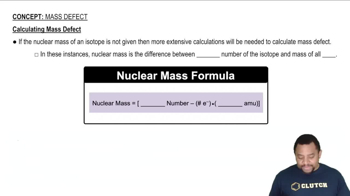If 1.0 g of matter is converted to energy, how much energy is formed?
Ch.21 - Radioactivity & Nuclear Chemistry

Chapter 21, Problem 68
Calculate the mass defect and nuclear binding energy per nucleon of each nuclide. a. Li-7 (atomic mass = 7.016003 amu)
 Verified step by step guidance
Verified step by step guidance1

Verified video answer for a similar problem:
This video solution was recommended by our tutors as helpful for the problem above.
Video duration:
8mWas this helpful?
Key Concepts
Here are the essential concepts you must grasp in order to answer the question correctly.
Mass Defect
The mass defect is the difference between the mass of an atomic nucleus and the sum of the individual masses of its protons and neutrons. This discrepancy arises because some mass is converted into energy when nucleons bind together, according to Einstein's equation E=mc². The mass defect is crucial for understanding nuclear stability and energy release in nuclear reactions.
Recommended video:
Guided course

Calculating Mass Defect
Nuclear Binding Energy
Nuclear binding energy is the energy required to disassemble a nucleus into its constituent protons and neutrons. It is directly related to the mass defect; the greater the mass defect, the higher the binding energy. This energy is a measure of the stability of a nucleus: a higher binding energy indicates a more stable nucleus, while a lower binding energy suggests it is more likely to undergo radioactive decay.
Recommended video:
Guided course

Nuclear Binding Energy
Binding Energy per Nucleon
Binding energy per nucleon is the average energy that binds each nucleon (proton or neutron) in a nucleus. It is calculated by dividing the total binding energy of the nucleus by the number of nucleons. This value is useful for comparing the stability of different nuclei; generally, nuclei with higher binding energy per nucleon are more stable and less likely to undergo fission or fusion.
Recommended video:
Guided course

Nuclear Binding Energy
Related Practice
Textbook Question
Textbook Question
A typical home uses approximately 1.0⨉103 kWh of energy per month. If the energy came from a nuclear reaction, what mass would have to be converted to energy per year to meet the energy needs of the home?
Textbook Question
Calculate the quantity of energy produced per gram of U-235 (atomic mass = 235.043922 amu) for the neutron-induced fission of U-235 to form Xe-144 (atomic mass = 143.9385 amu) and Sr-90 (atomic mass = 89.907738 amu) (discussed in Problem 57).
Textbook Question
Calculate the quantity of energy produced per mole of U-235 (atomic mass = 235.043922 amu) for the neutron-induced fission of U-235 to produce Te-137 (atomic mass = 136.9253 amu) and Zr-97 (atomic mass = 96.910950 amu) (discussed in Problem 58).
